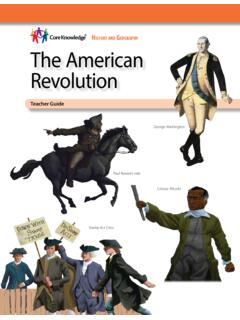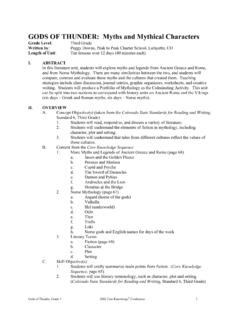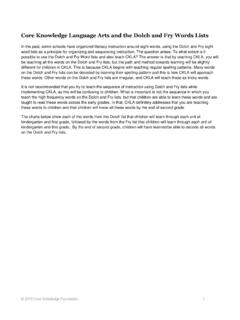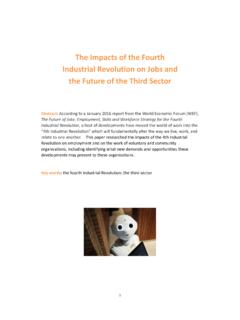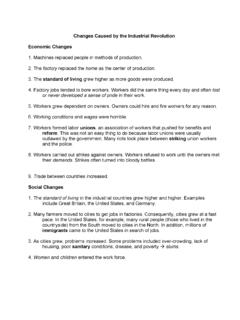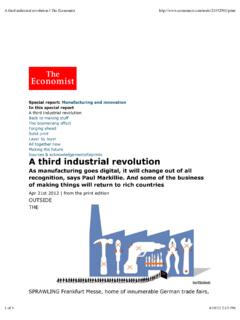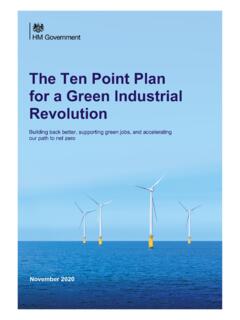Transcription of The Industrial Revolution: Changes and Challenges
1 The Industrial revolution : Changes and ChallengesTimeline CardsSubject Matter ExpertJ. Chris Arndt, PhD, Department of History, James Madison UniversityIllustration and Photo CreditsTitle Coal Riddling workshop, at the mines of Blanzy, (w/c), Bonhomme, Ignace Francois (1809 81)/CNAM, Conservatoire National des Arts et Metiers, Paris/Archives Charmet/Bridgeman ImagesIntroduction, Card 1 George III, 1771 (oil on canvas), Zoffany, Johann (1733 1810) / Royal Collection Trust Her Majesty Queen Elizabeth II, 2017 / Bridgeman ImagesIntroduction, Card 3 DeAgostini/SuperStockChapter 1, Card 1 Sir Thomas Lombe s Silk Mill, Derby, 18th century (print), Anonymous/Private Collection/Bridgeman ImagesISBN: 978-1- 68380 -335-5 Chapter 1, Card 2 Child and woman labour in the coal mines prior to 1843, drawn from contemporary prints, illustration from The Church of England.
2 A History for the People by Spence-Jones, pub. (litho) (later colouration), English School, (19th century) (after)/Private Collection/The Stapleton Collection/Bridgeman ImagesChapter 2, Card 1 Agriculture in the Middle Ages (colour litho), English School, (20th century) / Private Collection / Look and Learn / Bridgeman ImagesChapter 2, Card 2 Swiss peasant family (engraving), English School, (19th century)/Private Collection/ Look and Learn/Bridgeman ImagesChapter 3, Card 1 The Mill, 1751 (oil on canvas), Boucher, Francois (1703 70)/Louvre, Paris, France/Bridgeman ImagesChapter 3, Card 2 A Pit Head, 1825 (oil on canvas), English School, (19th century)/Walker Art Gallery, National Museums Liverpool/Bridgeman ImagesChapter 3, Card 3 The Industrial revolution , Lampitt, Ronald (Ron) (1906 88)/Private Collection/ Look and Learn/Bridgeman ImagesChapter 4, Card 1 Hargreaves Spinning-Jenny (engraving), English School, (19th century)/Private Collection/ Look and Learn/Bridgeman ImagesChapter 4, Card 1 Cotton factory floor, showing workers mule spinning, engraved by James Tingle ( 60) (litho), Allom, Thomas (1804 72) (after)/Private Collection/Photo Ken Welsh/Bridgeman ImagesChapter 4, Card 2 The Cotton Gin, from Scenes on a Cotton Plantation, 1867 (wood engraving), Waud, Alfred Rudolph (1828 91) (after)/Boston Athenaeum, USA/Bridgeman ImagesChapter 4, Card 3 Factory Chimneys, Howat, Andrew (20th Century)/Private Collection/ Look and Learn/Bridgeman ImagesChapter 5 Bristol Docks and Quay, (oil on canvas), English School, (18th century)
3 /Bristol Museum and Art Gallery, UK/Bridgeman ImagesChapter 6 Title page, The Wealth of Nations by Adam Smith, 1776 (print with handwritten annotation), English School, (18th century)/The University of St. Andrews, Scotland, UK/Bridgeman ImagesChapter 7, Card 1 Portrait of Charles Dickens (1812 70) , Glasgow, Alexander ( 84)/Private Collection/Photo Philip Mould Ltd, London/Bridgeman ImagesChapter 7, Card 2 Peace with Honour - Queen Victoria (1819 1901) with Benjamin Disraeli (1804 81) following the signing of the Berlin Treaty in 1878 (oil on canvas), Wirgman, Theodore Blake (1848 1925)/The FORBES Magazine Collection, New York/Bridgeman ImagesChapter 8 The Strike (Pittsburgh, 1877), 1886 (oil on canvas), Koehler, Robert (1850 1917)/Deutsches Historisches Museum, Berlin, Germany/ DHM/Bridgeman ImagesChapter 9 Robert Owen (oil on canvas), English School, (19th century)
4 /Private Collection/Bridgeman ImagesChapter 10, Card 1 Battle over the barricades on Alexanderplatz during the 1848 Revolutions, Berlin, 18th-19th March 1848 (colour litho), German School, (19th century) / Private Collection / SZ Photo / Sammlung Megele / Bridgeman ImagesChapter 10, Card 2 Karl Marx (photogravure), German Photographer, (19th century)/Private Collection/The Stapleton Collection/Bridgeman ImagesChapter 10, Card 2 Engels (photogravure), German Photographer, (19th century)/Private Collection/The Stapleton Collection/Bridgeman ImagesChapter 11 Strike, 1895 (oil on canvas), Munkacsy, Mihaly (1844 1900)/Hungarian National Gallery, Budapest, Hungary/Bridgeman ImagesChapter 12, Card 1 RubberBall/SuperStockChapter 12, Card 1 RubberBall/SuperStockChapter 12, Card 2 ICP/age fotostock/SuperStockChapter 12, Card 2 Richard Levine/age fotostock/SuperStockCreative Commons LicensingThis work is licensed under a Creative Commons Attribution-NonCommercial-ShareAlike International are free:to Share to copy, distribute, and transmit the work to Remix to adapt the work Under the following conditions:Attribution You must attribute the work in the following manner:This work is based on an original work of the Core Knowledge Foundation ( ) made available through licensing under a Creative Commons Attribution-NonCommercial-ShareAlike International License.
5 This does not in any way imply that the Core Knowledge Foundation endorses this You may not use this work for commercial purposes. Share Alike If you alter, transform, or build upon this work, you may distribute the resulting work only under the same or similar license to this one. With the understanding that: For any reuse or distribution, you must make clear to others the license terms of this work. The best way to do this is with a link to this web page: 2018 Core Knowledge Foundation Rights Knowledge , Core Knowledge Curriculum Series , Core Knowledge History and Geography and CKHG are trademarks of the Core Knowledge and trade names are shown in this book strictly for illustrative and educational purposes and are the property of their respective owners. References herein should not be regarded as affecting the validity of said trademarks and trade Industrial revolution : Changes AND CHALLENGESI ntroductionGeorge III was the king of Britain at the time that tensions between Britain and its colonies in North America continued to grow.
6 THE Industrial revolution : Changes AND CHALLENGESI ntroductionIn 1776, the British colonists in North America declared their independence from Great Britain. We hold these truths to be self-evident, that all men are created equal, that they are endowed by their Creator with certain unalienable rights, that among these are li fe, liberty, and the pursuit of Industrial revolution : Changes AND CHALLENGESI ntroductionThe French revolution , in which ordinary French citizens revolted against the monarchy and the nobility, took place several years after the American revolution . The storming of the Bastille in July 1789 sparked violence in the streets of Paris and throughout France. THE Industrial revolution : Changes AND CHALLENGESI ntroductionBy 1810, much of Europe was under the control of French Emperor Napoleon Bonaparte. Russia and the Ottoman Empire remained outside of his in 181060 N45 N15 W0 SwedenKingdom ofDenmarkandNorwayUnited KingdomofGreat Britainand IrelandKingdomof NaplesSardiniaSicilyCorsicaElbaSpainPort ugalFrenchEmpireAustrianEmpireRussianEmp irePrussiaOttomanEmpireIllyrianProvinces ParisBarcelonaMadridLisbonMarseilleBruss elsPragueViennaLondonVersaillesNaplesMed iterranean SeaBlack SeaBaltic SeaNorthSeaAegean SeaATLANTICOCEANL oire RiverRhiue RiverAmiensDanube RiverConfederationof theRhinePo River60 N0 15 EWarsawGrandDuchy ofWarsawElbe RiverBerlinAdriatic SeaMilanRomeKingdomof ItalyFrench EmpireCountries allied with NapoleonCountries controlled by NapoleonCountries at war with Napoleon0500 milesNSEWH elveticRepublicTHE Industrial revolution : Changes AND CHALLENGESCHAPTER 1.
7 Effects of the Industrial RevolutionFactories became widespread throughout Great Britain during the Industrial revolution . Big Question: How would you describe working conditions in the early part of the Industrial revolution ?THE Industrial revolution : Changes AND CHALLENGESCHAPTER 1: Effects of the Industrial RevolutionChild labor was common in coal mines and Question: How would you describe working conditions in the early part of the Industrial revolution ?THE Industrial revolution : Changes AND CHALLENGESCHAPTER 2: Before the Industrial RevolutionTending to the fields, as well as planting and harvesting, were very important jobs for Question: What was rural life like for ordinary people before the Industrial revolution ?THE Industrial revolution : Changes AND CHALLENGESCHAPTER 2: Before the Industrial RevolutionHaving enough food to eat and staying warm and healthy were important concerns for poor farmers and Question: What was rural life like for ordinary people before the Industrial revolution ?
8 THE Industrial revolution : Changes AND CHALLENGESCHAPTER 3: Moving Toward the Industrial AgeNew inventions and techniques, such as the use of energy from waterwheels to grind more flour, made food more abundant with less Question: In what ways did the inventions of the Industrial revolution impact people s lives?THE Industrial revolution : Changes AND CHALLENGESCHAPTER 3: Moving Toward the Industrial AgeIn 1768, James Watts developed a more efficient steam engine to pump water out of coal mines, making it easier to dig for Question: In what ways did the inventions of the Industrial revolution impact people s lives?THE Industrial revolution : Changes AND CHALLENGESCHAPTER 3: Moving Toward the Industrial AgeWith the development of the first steam locomotive in 1804, both people and goods could be transported more easily and for longer Question: In what ways did the inventions of the Industrial revolution impact people s lives?
9 THE Industrial revolution : Changes AND CHALLENGESCHAPTER 4: From Farms to Factories and CitiesIn the mid-1700s, the invention of the spinning jenny and the mule dramatically changed how cloth was created. Work moved from people s homes to large Question: What developments in the manufacturing of cloth caused mass migration to Industrial towns and cities?THE Industrial revolution : Changes AND CHALLENGESCHAPTER 4: From Farms to Factories and CitiesIn 1792, Eli Whitney invented the cotton gin, contributing to the growth of slavery in the American South and the growth of factories in Question: What developments in the manufacturing of cloth caused mass migration to Industrial towns and cities?THE Industrial revolution : Changes AND CHALLENGESCHAPTER 4: From Farms to Factories and CitiesCities grew around new factories. Manchester, England, had ninety-nine cotton spinning mills by Question: What developments in the manufacturing of cloth caused mass migration to Industrial towns and cities?
10 THE Industrial revolution : Changes AND CHALLENGESCHAPTER 5: The Rise of CapitalismAccording to the mercantilist theory, a country could grow rich and powerful by controlling trade. If it could force rival nations to buy its goods, it could increase the amount of silver and gold it had. Big Question: What was mercantilism?THE Industrial revolution : Changes AND CHALLENGESCHAPTER 6: Adam SmithIn The Wealth of Nations, published in 1776, Adam Smith supported capitalism, noting that the law of supply and demand provides a natural balance in the Question: What were Adam Smith s basic economic beliefs?THE Industrial revolution : Changes AND CHALLENGESCHAPTER 7: Living in the Industrial EraCharles Dickens s novels led to greater awareness of the hard lives of the poor in England. Big Question: What were the advantages and disadvantages of the Industrial era?THE Industrial revolution : Changes AND CHALLENGESCHAPTER 7: Living in the Industrial EraBenjamin Disraeli, prime minister under Queen Victoria, worked to pass laws benefiting the working classes.
